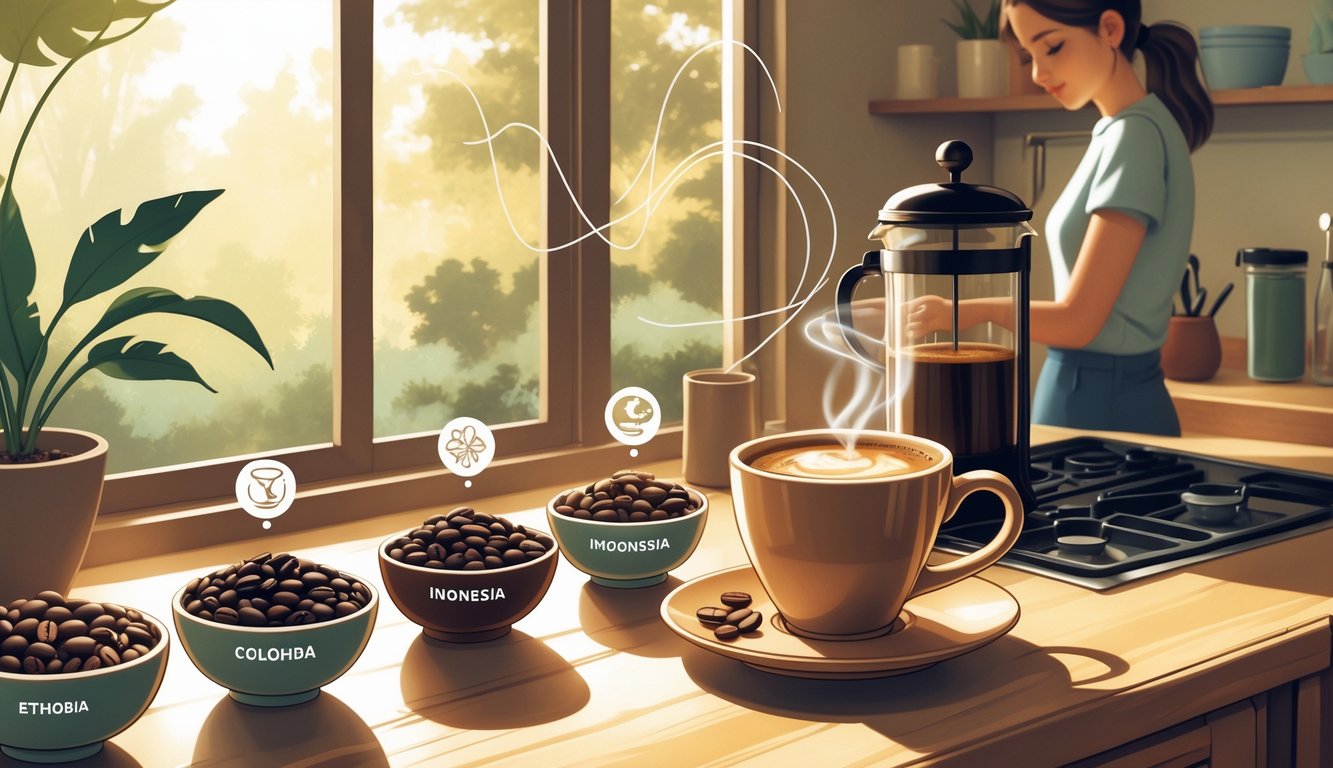
Ethiopian Coffee and Its Legacy
Ethiopia, where coffee started, refuses to play by anyone’s rules. I once had a Yirgacheffe in a cramped Addis café—owner listed a dozen varietals, I forgot all of them, but that lemon-jasmine aftertaste? Still remember it. No two bags taste the same, and that’s the whole point.
Washed vs. natural process? Feels pointless to argue—washed gives you bright floral layers, natural is wild, funky, sometimes like fermented blueberries. If you want to show off, bring Sidamo beans to a cupping party. Trust me.
Tradition still matters. Some study in the Journal of Ethnopharmacology claims Ethiopian coffee ceremonies lower stress, but last time I watched, everyone was just gossiping. Specialty buyers chase single origins, exporters chase trends, and quality swings all over the place.
Exploring Indonesian Coffee Varieties
Indonesia is chaos. In a good way. Sumatra’s Arabica is unpredictable—wet hulling (Giling Basah) means funky, earthy, sometimes spicy flavors. Try explaining that to someone raised on supermarket Colombian. Aceh and Mandheling beans? One bag tasted like pipe tobacco and grapefruit. Didn’t even finish it.
Java used to mean “coffee,” but now Robusta dominates most lowland farms—cheap, sturdy, rarely interesting. Fun fact: Kopi Luwak (yep, the civet one) started here. Don’t bother; it’s mostly hype and, honestly, kind of gross.
Sulawesi (Toraja), Bali, Flores—they all pump out rare, complex lots for specialty shops, but nothing tastes the same twice. Here’s a table with the quirks. Want predictability? Stick to South America. Want surprises? Indonesian coffee will mess with your expectations and your palate.
| Island/Region | Processing Style | Common Flavors | Arabica/Robusta Ratio |
|---|---|---|---|
| Sumatra | Wet hulling | Earthy, spicy, brooding | Mostly Arabica |
| Java | Washed/mixed | Winey, soft, sweet, woody | 50/50 in lowlands |
| Sulawesi | Washed, wet-hull | Herbal, cocoa, complex body | Mostly Arabica |
| Bali | Wet-processed | Citrus, floral, clean finish | Mostly Arabica |
How Coffee Origins Influence Your Morning Cup
Okay, so here’s the thing: every time I rip open a new bag of beans, I get this weird “spin the globe” feeling. Maybe it’s Ethiopia, maybe it’s Colombia, maybe it’s just a cup that tastes like regret. Sometimes I honestly wonder if coffee’s just a caffeine delivery system or if I’m supposed to be thinking about “notes” and “rituals” and all that. I’m never awake enough to care, but then again, I’m still late for everything.
Distinct Regional Flavor Profiles
Let’s not pretend all coffee tastes remotely similar. I mean, Ethiopian beans? Those are like drinking someone’s flower garden (in a good way… I think?), and then Brazil is just, I don’t know, hot chocolate’s grumpy cousin. I tried a Panama Geisha once and felt like my taste buds needed therapy.
Here’s a table I threw together because, honestly, those fancy flavor wheels are exhausting:
| Origin | Common Notes | My Cheap Analogy |
|---|---|---|
| Ethiopia | Floral, Fruity | Like a fruit salad |
| Colombia | Nutty, Balanced | Candy bar in a cup |
| Brazil | Chocolate, Earthy | Hot cocoa’s cousin |
| Indonesia | Spicy, Herbal | Soup gone rogue |
Some coffee pro told me—completely straight-faced—“If you don’t get excited over a washed Yirgacheffe, you’re missing out.” Sure, but half the time I just want something to keep my eyelids open.
Impact on Morning Coffee Rituals
Pour-over or espresso? No clue. I stand there staring at my grinder like it’s going to answer me. Guatemalan beans? They jam up the grinder every time. Jamaican Blue Mountain? Goes through like it’s nothing. There’s no “best” way. Every origin, every morning, total wild card.
I read this farm-to-cup story and apparently one Colombian farm can cram six flavors into a single cup. Who’s got time to notice? My friend swears by Vietnamese robusta for late mornings. I just give up on milk if the beans are Kenyan. “Proper” seems like a myth. I’m pretty sure the only real rule is: there are no rules.
And yet, somehow, my mood hinges on whether I go citrus or nutty. My receipts say I’m not making this up: what I brew messes with my whole day.
From Coffee Plant to Cup: Tracing the Origin
Nobody really talks about how unglamorous this gets. It’s not just “beans from a mountain.” It’s Arabica, robusta, sorting, grading, drying, green coffee bouncing around the planet for weeks before someone finally roasts it. It’s a logistical nightmare, honestly.
I dug into this origin breakdown and now I can’t stop thinking about sorting machines and moisture meters. One tiny mistake and my French press tastes like wet cardboard. Romantic, right?
We all pretend there’s some magic journey, but all I want is a cup that clues me in on which continent I’m drinking. Weirdly, knowing my beans grew in volcanic dirt does make me less grumpy about slow mornings—even if I’m still late for Zoom calls.
Brewing Methods for Regional Coffee Beans
Flip the bag over, squint at the label—seriously, why is the print always microscopic? No one tells you that drowning Ethiopia Yirgacheffe in a drip machine is a crime, or that Sumatra Mandheling basically begs for French press and just sulks if you use a V60. Brewing methods can make a bean sing or just flatten it into oblivion. Ask me about the time I wasted $20 beans by brewing them into bland sadness. Actually, don’t.
Pour-Over for Single-Origin Experiences
I’ll admit, my first pour-overs were a disaster—just brown water, no flavor, total mess. But after a while, I realized pour-over (V60, Chemex, whatever, pick your poison) is the only way to actually taste what the beans are about. Coffee shops love to nerd out on extraction, water temp, grind size, and all that jazz. Somewhere on the global flavor guide, there’s a chart that says different regions need “microscopic tweaks.” I barely have the patience for that.
Central American beans? I go 202°F, medium-fine, pour slow. Aeropress fans, look, I hear you, but I’m not convinced. Ethiopian beans go all citrus if you don’t mess up the pour, but if you rush, it’s just hot water with a hint of disappointment. Clarity’s great, but only if you’re not in a hurry. And kettles? I’ve owned three, none of them “perfect.”
French Press and Full-Bodied Coffees
French press and Sumatran or Brazilian beans? You get body. Like, a lot. The method just slams you with texture and hides most of the subtle stuff. Someone at Not Not Coffee says Brazilian beans throw out chocolate notes like they’re showing off. No filter paper means all the oils and micro-grounds stick around—sometimes in your cup, sometimes in your teeth. Sorry, but it’s true.
Colombian beans get weird in a French press. Lighter roasts taste flat, darker ones get chewy. Every time I grind too fine, I get sludge. Nobody told me coarse grind was non-negotiable until I’d already ruined three plungers.
Steep time? Four minutes, minimum, unless you like sour coffee. French press works for big, bold beans, but ruins delicate acidity. Want crema? Go buy an espresso machine.



